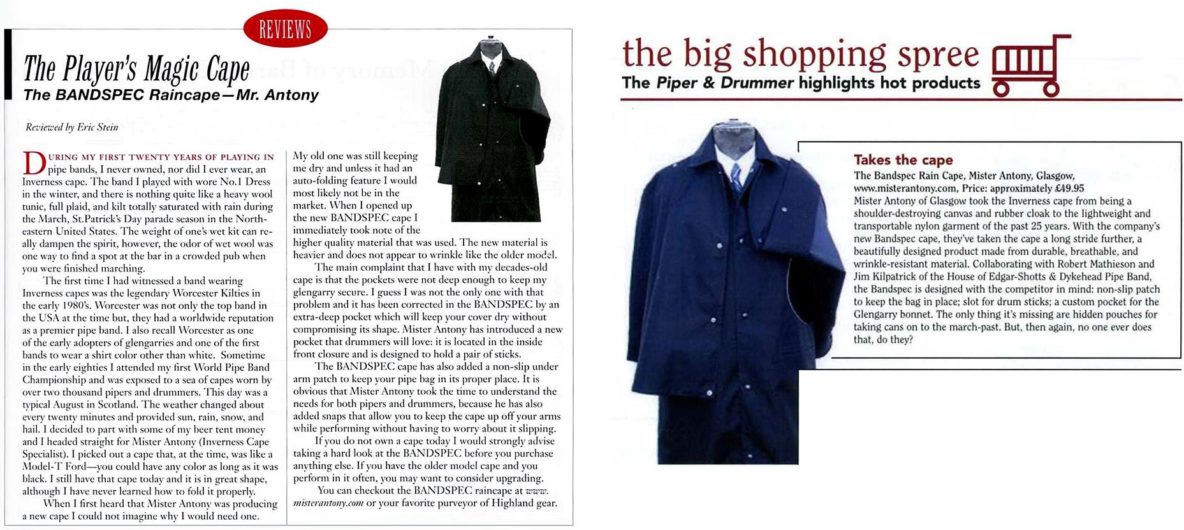Mist, Moors and a Better Rain Cape
BEFITTING a musical form so closely identified with the oft-dreary clime of Scotland, bagpiping is an all-weather pursuit. Bands routinely perform in the rain, protecting their pipes and kilts by donning Inverness capes. These waterproof, sleeveless garments, beloved by fictional detective Sherlock Holmes, allow a piper to play “Braes of Lochiel” without getting soaked to the bone.
Yet for hardcore bagpipers, the classic Inverness cape is not without its flaws. In his 24 years running Mister Antony, a cape maker based in Glasgow, Antony Mistofsky heard various quibbles from his clients. So in 2003, he began developing a cape that would assuage the nitpickers — the Bandspec Raincape, an article of clothing that Mister Antony advertises as “The First Choice for Champions.”
When starting on the Bandspec, Mr. Mistofsky sought the advice of Robert Mathieson, pipe major for the celebrated Shotts & Dykehead Caledonia Pipe Band. The two spent hours discussing where Mister Antony’s Inverness cape fell short in terms of comfort and performance. They concurred that the first problem they needed to address was bagpipe slippage.
“When you’re out standing in the rain and you place your velvet pipe underneath your arm, it tends to slip,” said Mr. Mistofsky, ascribing this drawback to the properties of nylon, the standard fabric for Inverness capes. The solution was to sew a patch of clingy material onto the Bandspec’s left side, where a bagpiper cradles his instrument between arm and torso.
A second common gripe brought up by Mr. Mathieson was pocket size. The item that bagpipers most desire to stow away, he said, is their Glengarry, a traditional Scottish cap with flowing ribbons. Yet the pockets on a typical Inverness cape aren’t deep enough to accommodate it. Mr. Mistofsky corrected that oversight on the Bandspec, giving it an extra-long pocket especially designed for Glengarries. He also added an interior pocket for drumsticks, the better to make the Bandspec appeal to percussionists as well as pipers.
Since pipe bands frequently travel to competitions and parades, the Bandspec’s designers made the cape out of a wrinkle-resistant polyester. This, said Mr. Mistofsky, enables pipers to appear as if they’ve just ironed their uniforms, even if they just got off a plane from Aberdeen.
As Mr. Mathieson tested out various Bandspec prototypes over a nine-month period, he suggested a final tweak: the addition of studs that allow for the cape’s front flaps to snap onto the shoulders. Mr. Mistofsky said this feature was best used on windy days when strong gusts might send a cape’s flaps flying into a piper’s face.
The final Bandspec design received Mr. Mathieson’s approval toward the end of 2004 and went on sale in January of 2005. “I would love to tell you that we supply them to Macy’s or Saks Fifth Avenue, but these are not the sorts of stores where they sell,” said Mr. Mistofsky, whose family has been in the Scottish rainwear industry for nearly a century. Instead, the Bandspec, which retails for around $90, is available throughout the US at shops that specialize in quality bagpiping gear. ( To find a local US retailer and for more information please enquire at www.misterantony.com )
Mr. Mistofsky declined to say how many Bandspecs he had sold so far, however, he did point out a positive review the cape received in The Voice, a magazine published by the Eastern United States Pipe Band Association.
In addition to lauding the Bandspec, the reviewer alludes to the fact that it’s only available in black. Perhaps to the disappointment of all bagpiping Sherlock Holmes fans, there is no houndstooth Bandspec at present. But that is probably a demographic that Mr. Mistofsky can survive without.
By BRENDAN I. KOERNER
Published: November 5, 2006
